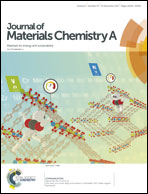Oxygen vacancy mediated construction of anatase/brookite heterophase junctions for high-efficiency photocatalytic hydrogen evolution†
Abstract
In the past several years, the exploration of non-stoichiometric metal oxides has triggered an explosion of interest for many important applications, while the contribution of oxygen vacancy defects to the photocatalytic performance of surface heterophase junctions is still an open question. In this paper, a hydrogenation treatment method was used to fabricate defect-rich heterophase junctions. Experimental characterization indicated that the generation of oxygen vacancies not only influenced the electronic structure of TiO2 nanofibers, but also facilitated the phase transformation from anatase/rutile to anatase/brookite junctions. For improved interfacial charge separation, a novel urea-assisted strategy was further developed to achieve the subsequent rearrangement of oxygen vacancy defects. As a result, ESR and XPS measurements evidenced the diminishment of bulk defects and the preservation of surface oxygen vacancies. Anatase/brookite heterophase junctions with surface oxygen vacancies exhibited an unprecedented hydrogen production rate of 1.6 mmol h−1, which was more than 12 times higher than that of pristine TiO2 nanofibers. Our work revealed the significant impact of oxygen vacancies on the phase and electronic structures of heterophase junctions. It also provided an effective strategy to develop highly active TiO2-based photocatalysts through integrating defect modulation and junction design.



 Please wait while we load your content...
Please wait while we load your content...